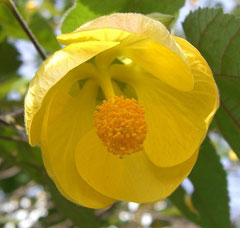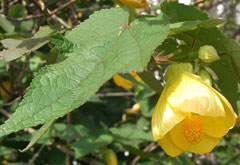 |
|
http://de.wikipedia.org/wiki/Benutzer:Morray |
 |
|
Translate this page:
Summary
Bloom Color: Yellow.
Main Bloom Time: Early spring, Mid spring. Form: Spreading or horizontal, Upright or erect.
Physical Characteristics

 Abutilon pictum is an evergreen Shrub growing to 5 m (16ft) by 2 m (6ft) at a medium rate.
Abutilon pictum is an evergreen Shrub growing to 5 m (16ft) by 2 m (6ft) at a medium rate.
See above for USDA hardiness. It is hardy to UK zone 9 and is frost tender. It is in leaf all year, in flower from April to September. The species is hermaphrodite (has both male and female organs).
Suitable for: light (sandy), medium (loamy) and heavy (clay) soils. Suitable pH: mildly acid, neutral and basic (mildly alkaline) soils. It can grow in semi-shade (light woodland) or no shade. It prefers moist soil.
UK Hardiness Map
US Hardiness Map
Synonyms
Plant Habitats
Woodland Garden Sunny Edge; Dappled Shade; South Wall. By. West Wall. By.
Edible Uses
Flowers - raw or cooked. A delicious sweet flavour[K]. The flowers produce nectar all the time they are open so, assuming the plant is grown indoors and is not visited by pollinating insects, the sweetness increases the longer the flower is open[K].
References More on Edible Uses
Medicinal Uses
Plants For A Future can not take any responsibility for any adverse effects from the use of plants. Always seek advice from a professional before using a plant medicinally.
None known
References More on Medicinal Uses
The Bookshop: Edible Plant Books
Our Latest books on Perennial Plants For Food Forests and Permaculture Gardens in paperback or digital formats.

Edible Tropical Plants
Food Forest Plants for Hotter Conditions: 250+ Plants For Tropical Food Forests & Permaculture Gardens.
More

Edible Temperate Plants
Plants for Your Food Forest: 500 Plants for Temperate Food Forests & Permaculture Gardens.
More

More Books
PFAF have eight books available in paperback and digital formats. Browse the shop for more information.
Shop Now
Other Uses
References More on Other Uses
Cultivation details
Landscape Uses:Border, Container, Hedge, Specimen. Requires a sunny position or part day shade in a fertile well-drained soil[200]. Dislikes drought[200]. This species is only hardy in the very mildest areas of Britain, being intolerant of temperatures that fall much below 0°c[260]. Plants are often deciduous in cold winters[219]. A deep mulch in winter and tying in growth to the wall will maximise protection in winter[200]. If the plant is cut back by cold weather, it can resprout from the base in the spring and can flower on the current year's growth[202]. A very ornamental plant, there are several named varieties[200]. Several of the cultivars have golden-variegated leaves caused by a virus infection, this infection can spread to other plants[260]. Tip-prune young plants to promote a bushy habit[200]. Older plants tend to get rather leggy, but can be cut back almost to the base in order to promote new growth. This is best done in late winter as the plant starts to come into growth[260]. Plants in this genus are notably resistant to honey fungus[200]. Special Features:Attractive foliage, Not North American native, Naturalizing.
References Carbon Farming Information and Carbon Sequestration Information
Temperature Converter
Type a value in the Celsius field to convert the value to Fahrenheit:
Fahrenheit:
The PFAF Bookshop
Plants For A Future have a number of books available in paperback and digital form. Book titles include Edible Plants, Edible Perennials, Edible Trees,Edible Shrubs, Woodland Gardening, and Temperate Food Forest Plants. Our new book is Food Forest Plants For Hotter Conditions (Tropical and Sub-Tropical).
Shop Now
Plant Propagation
Seed - sow spring in a greenhouse[200]. Germination should take place within a few weeks. Once the seedlings are large enough to handle, prick them out into individual pots. Grow them on for at least the first winter in a greenhouse and plant out in late spring or early summer, after the last expected frosts. Cuttings of young shoots, June in a frame[200]. Grow on in the greenhouse for their first winter and plant out in spring after the last expected frosts. Cuttings of half-ripe wood, July/August in a frame[200]. Grow on in the greenhouse for their first winter and plant out in spring after the last expected frosts.
Other Names
If available other names are mentioned here
Native Range
SOUTHERN AMERICA: Brazil (south), Argentina (Corrientes, Misiones), Paraguay, Uruguay
Weed Potential
Right plant wrong place. We are currently updating this section.
Please note that a plant may be invasive in one area but may not in your area so it's worth checking.
Conservation Status
IUCN Red List of Threatened Plants Status :

Growth: S = slow M = medium F = fast. Soil: L = light (sandy) M = medium H = heavy (clay). pH: A = acid N = neutral B = basic (alkaline). Shade: F = full shade S = semi-shade N = no shade. Moisture: D = dry M = Moist We = wet Wa = water.
Now available:
Food Forest Plants for Mediterranean Conditions
350+ Perennial Plants For Mediterranean and Drier Food Forests and Permaculture Gardens.
[Paperback and eBook]
This is the third in Plants For A Future's series of plant guides for food forests tailored to
specific climate zones. Following volumes on temperate and tropical ecosystems, this book focuses
on species suited to Mediterranean conditions—regions with hot, dry summers and cool, wet winters,
often facing the added challenge of climate change.
Read More
Expert comment
Author
(Gillies. ex Hook.&Arn.)Walp.
Botanical References
200
Links / References
For a list of references used on this page please go here
Readers comment
© 2010, Plants For A Future. Plants For A Future is a charitable company limited by guarantee, registered in England and Wales. Charity No. 1057719, Company No. 3204567.